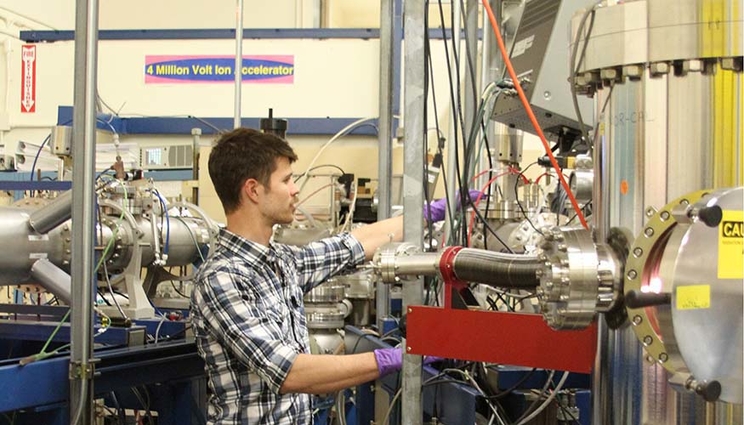Researchers discover cause of radiation defects
 (Download Image)
LLNL scientist Joseph Wallace adjusts the microbeam aperture on the Rutherford backscattering spectrometry system, which is used to characterize radiation damage as a function of depth in the samples.
(Download Image)
LLNL scientist Joseph Wallace adjusts the microbeam aperture on the Rutherford backscattering spectrometry system, which is used to characterize radiation damage as a function of depth in the samples.
A team of scientists from Lawrence Livermore National Laboratory (LLNL) and Texas A&M University got a step closer to understanding radiation damage phenomena. They found that the density of collision cascades has a profound effect on defect interaction dynamics in silicon.
The team calculated cascade densities with a model that considers their fractal nature and, by using a recently developed pulsed ion beam method, systematically studied temperature dependencies of the rate of defect interaction in silicon bombarded with ions in a wide range of masses -- from neon to xenon -- creating collision cascades with vastly different densities. The research appears in the May 25 edition of the journal Physical Review Letters.
Understanding how radiation defects are formed remains a major materials physics challenge. This applies even to the best studied and arguably simplest material, crystalline silicon, which is the backbone of modern electronics. The complexity is largely related to the dynamic nature of radiation defect formation. For most practical cases, the point defects generated in the initial ballistic phase of the collision cascade are mobile and interact with each other. Because of this dynamic interaction, only a fraction of the point defects generated in cascades ends up forming stable radiation damage. The rest disappears via recombination of vacancies and interstitials. Such dynamics of radiation defect formation is difficult to study experimentally and remains poorly understood.
"The new results resolve an old puzzle of radiation materials physics," said Sergei Kucheyev, the LLNL project lead. "They can be used to predict radiation defect dynamics in silicon and provide a blueprint for future studies of radiation defect dynamics in other technologically relevant materials."
Understanding radiation damage is important for nuclear materials performance and for electronic materials where it is a concomitant and often deleterious effect of ion-beam processing steps such as doping and etching. These results can be used to predict the ranges of process conditions where the dynamic defect interaction phenomena are pronounced or less important.
The number of ballistically generated displacements can be readily calculated and is typically expressed as displacements per atom (DPAs). However, understanding of the correlation between DPAs and the amount of stable lattice disorder has remained elusive, primarily because of the dynamic nature of the defect formation. For the same DPAs, the amount of stable radiation damage depends on several irradiation conditions such as temperature, dose rate, ion mass, energy and the depth from the sample surface.
The results have demonstrated that the complex, multiparameter dependence of defect dynamics on irradiation conditions can be reduced to a deterministic effect of a single parameter, the collision cascade density, calculated with a model that considers the fractal nature of collision cascades. The density of collision cascades determines the lifetime of point defects, which is the time it takes for them to annihilate or interact to form stable damage. Defects in denser cascades take longer to decay, and a change in the dominant process of defect interaction occurs at higher temperatures.
The work was funded by the Nuclear Energy Enabling Technology (NEET) program of DOE’s Office of Nuclear Energy. The other team members include L. Bimo Bayu Aji and Joseph Wallace from LLNL and Lin Shao from Texas A&M University.
Contact
 Anne M. Stark
Anne M. Stark
[email protected]
(925) 422-9799
Related Links
Physical Review LettersTexas A&M University
Tags
Physical and Life SciencesFeatured Articles







